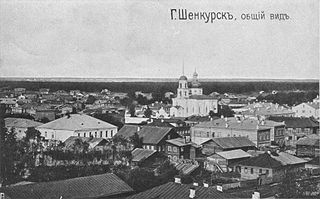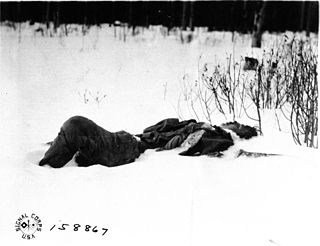
The Battle of Stoney Creek was a British victory over an American force fought on 6 June 1813, during the War of 1812 near what is now Stoney Creek, Ontario, Canada. British units made a night attack on the American encampment, and due in large part to the capture of the two senior officers of the American force and an overestimation of British strength by the Americans, the outcome of the battle was a total victory for the British, and a turning point in the defence of Upper Canada.

The siege of Fort Erie, also known as the Battle of Erie, from 4 August to 21 September 1814, was one of the last engagements of the War of 1812, between British and American forces. It took place during the Niagara campaign, and the Americans successfully defended Fort Erie against a British army. During the siege, the British suffered high casualties in a failed storming attempt; they also suffered casualties from sickness and exposure in their rough encampments. Unaware that the British were about to abandon the siege, the American garrison launched a sortie to destroy the British siege batteries, during which both sides again suffered high losses.

The Battle of Big Bethel was one of the earliest, if not the first, land battle of the American Civil War. It took place on the Virginia Peninsula, near Newport News, on June 10, 1861.

Fort Harrison was a War of 1812 era stockade constructed in Oct. 1811 on high ground overlooking the Wabash River on a portion of what is today the modern city of Terre Haute, Indiana, by forces under command of Gen. William Henry Harrison. It was a staging point for Harrison to encamp his forces just prior to the Battle of Tippecanoe a month later. The fort was the site of a famous battle in the War of 1812, the siege of Fort Harrison in Sept. 1812 that was the first significant victory for the U.S. in the war. The fort was abandoned in 1818 as the frontier moved westward.

The Battle of Apache Pass was fought in 1862 at Apache Pass, Arizona, in the United States, between Apache warriors and the Union volunteers of the California Column. It was one of the largest battles between the Americans and the Chiricahua during the Apache Wars.
The Battle of Longwoods took place during the Anglo-American War of 1812. On 4 March 1814, a mounted American raiding party defeated an attempt by British regulars, volunteers from the Canadian militia and Native Americans to intercept them near Wardsville, in present-day Southwest Middlesex, Ontario.
Brevet Lieutenant-Colonel Benjamin Forsyth served as a United States Army officer during the War of 1812. Born in North Carolina, Forsyth joined the United States Army in 1800 as an officer and was a captain of the Regiment of Riflemen at the outbreak of war in 1812. He led raids into Upper Canada along the Saint Lawrence River in 1812–13 before transferring south and taking part in the battles of York and Fort George. Brevetted to lieutenant-colonel, he held command along Lake Champlain. He was mortally wounded at Odell Town, Lower Canada, in 1814.
The Battle of Connecticut Farms, fought June 7, 1780, was one of the last major battles between British and American forces in the northern colonies during the American Revolutionary War. Hessian General Wilhelm von Knyphausen, in command of the British garrison at New York City, made an attempt to reach the principal Continental Army encampment at Morristown, New Jersey. Knyphausen's advance was strongly met by companies of the New Jersey militia at Connecticut Farms. After stiff resistance, the militia were forced to withdraw, but the battle and skirmishing that preceded it sufficiently delayed Knyphausen's advance that he remained there for the night. After realizing that further advance on Morristown would probably be met by even more resistance, Knyphausen withdrew back toward New York.

The 19th Regiment Indiana Volunteer Infantry was an infantry regiment that served in the Union Army during the American Civil War. It was one of the original regiments in the Army of the Potomac's Iron Brigade.

The Battle of Tulgas was part of the North Russia Intervention into the Russian Civil War and was fought between Allied and Bolshevik troops on the Northern Dvina River 200 miles south of Arkhangelsk. It took place on the day the armistice ending World War I was signed, November 11, 1918, and is sometimes referred to as "The Battle of Armistice Day." Shortly before the battle, the freezing of the local waterways resulted in the cutting off of the Tulgas Garrison from outside assistance, and the freezing of the ground let the Bolsheviks move troops to surround Tulgas. The Bolsheviks used this opportunity and their superior numbers to try to attack and conquer the isolated outpost, but were driven back with severe losses.

The Battle of Shenkursk, in January 1919, was a major battle of the Russian Civil War. Following the Bolshevik loss at the Battle of Tulgas, the Red Army's next offensive action was against the Allied garrison of Shenkursk; located on the Vaga River. Allied forces in Shenkursk and the surrounding villages included men primarily from the United States and the United Kingdom with support from the White Russians. The battle ended with an Allied retreat from Shenkursk ahead of a superior Bolshevik army.

The siege of Apia, or the battle of Apia, occurred during the Second Samoan Civil War in March 1899 at Apia. Samoan forces loyal to Malietoa Tanumafili I were besieged by a larger force of Samoan rebels loyal to Mata'afa Iosefo. Supporting Malietoa were landing parties from four British and American warships. Over the course of several days of fighting, the Samoan rebels were defeated.
The Battle of La Flor was fought in May 1928 between the United States Marines, their Nicaraguan National Guardsmen allies, and a force of Sandinista rebels. It occurred at a hill north of the La Flor coffee plantation and ended with a rebel victory when the Americans and Nicaraguan National Guard troops were forced to withdraw.

The Second Battle of Las Cruces, or the New Year's Day Battle, was a major engagement during the American occupation of Nicaragua. It was fought on 1 January 1928, during an expedition to destroy a Sandinista fortress. A column of United States Marines and Nicaraguan National Guardsmen were attacked by a superior force of rebels entrenched on Las Cruises Hill and, after a long battle, the Americans and Nicaraguans routed the Sandinistas and captured their positions.

The Third Battle of Ciudad Juarez, or simply the Battle of Juarez, was the final major battle involving the rebels of Francisco "Pancho" Villa. It began on June 15, 1919, when Villa attempted to capture the border city of Ciudad Juarez from the Mexican Army. During the engagement the Villistas provoked an intervention by the United States Army protecting the neighboring city of El Paso, Texas. The Americans routed the Villistas in what became the second largest battle of the Mexican Revolution involving the US, and the last battle of the Border War. With the American army closing in, the Villistas had no choice but to retreat. Pancho Villa then attacked Durango but lost again, so he retired to his home at Parral, Chihuahua in 1920, with a full pardon from the Carrancista government.

The Battle of Bolshie Ozerki was a major engagement fought during the Allied North Russia Intervention in the Russian Civil War. Beginning on March 31, 1919, a force of British, American, Polish, and White Russian troops engaged several Red Army partisan regiments at the village of Bolshie Ozerki. Although the initial Allied attacks were repelled, the outnumbered Allies managed to repel the Soviet flanking attempts that followed and the Red Army was later ordered to withdraw. Allied forces began to withdraw rapidly from northern Russia shortly thereafter.

The Regiment of Riflemen was a unit of the U.S. Army in the early nineteenth century. Unlike the regular US line infantry units with muskets and bright blue and white uniforms, this regiment was focused on specialist light infantry tactics, and were accordingly issued rifles and dark green and black uniforms to take better advantage of cover. This was the first U.S. rifleman formation since the end of the American Revolutionary War 25 years earlier.
Where can you find troops more efficient than Morgan's riflemen of the Revolution or Forsyth's riflemen of the last war with Great Britain?
Under the designation Regiment of Light Dragoons existed two different units of the U.S. Army in the late eighteenth and early nineteenth centuries, respectively. A first unit of its name was short lived, established just prior the Quasi-War with France, in 1798 and discharged in 1800.
The raid on Newry took place in November 1689 during the Williamite War in Ireland when a Franco-Irish force loyal to James II attacked the Williamite garrison of Newry in County Down. The raid was carried out by the French Major General Alexandre de Rainier de Droue, Marquis de Boisseleau a French officer serving with James' Irish Army. It was largely unsuccessful and the Jacobite forces withdrew having suffered casualties.
The Battle of Conjocta Creek was an attempt by British forces under the command of Lieutenant Colonel John Tucker to raid the American supply depots at the towns of Black Rock and Buffalo. The Raid was ordered by British Lieutenant General Gordon Drummond in hopes of causing an early American surrender at Fort Erie. On the morning of August 3, 1814, Tucker and his men met a small force of American riflemen under the command of Major Lodwick Morgan. After fighting for about an hour, Tucker and his men were defeated, and withdrew across the Niagara river to Canada. The battle played a major role in the Siege of Fort Erie's failure, due to the supply post at Black Rock being able to continue supplying the American force defending Fort Erie. This resulted in the British eventually withdrawing from their siege positions around the fort to Chippawa on September 21, 1814.













